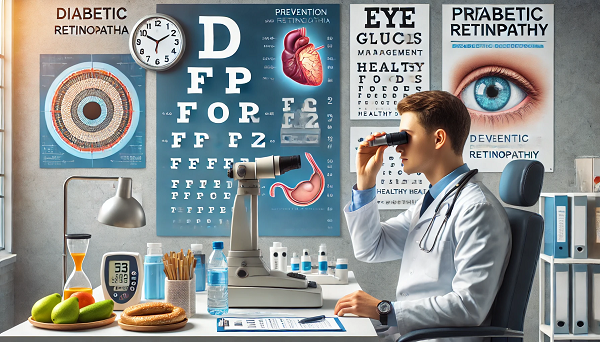Among the various complications associated with diabetes, one of the most significant and potentially devastating is diabetic retinopathy. If not appropriately managed, this eye condition can lead to vision loss and blindness. This blog article will explore the relationship between diabetes and eye health, focusing on preventing diabetic retinopathy.
Understanding Diabetic Retinopathy
Diabetic retinopathy is a complication of diabetes that affects the blood vessels in the retina, the light-sensitive tissue at the back of the eye. High blood sugar levels can damage these blood vessels, causing them to leak or become blocked, leading to vision problems. Diabetic retinopathy progresses through four stages:
- Mild Nonproliferative Retinopathy is the earliest stage, characterized by small areas of balloon-like swelling in the retina’s tiny blood vessels.
- Moderate Nonproliferative Retinopathy: Some blood vessels that nourish the retina are blocked as the disease progresses.
- Severe Nonproliferative Retinopathy: More blood vessels are blocked, depriving several areas of the retina of their blood supply, which prompts the retina to signal the growth of new blood vessels.
- Proliferative Diabetic Retinopathy (PDR): This is the most advanced stage, in which the signals sent by the retina for nourishment trigger the growth of abnormal and fragile new blood vessels. These new blood vessels can leak blood, leading to severe vision loss and possibly blindness.
Risk Factors:
Several factors increase the risk of developing diabetic retinopathy, including:
- Duration of Diabetes: The longer you have diabetes, the greater your risk of developing diabetic retinopathy.
- Poor Blood Sugar Control: Consistently high blood sugar levels increase the risk of all diabetic complications, including retinopathy.
- High Blood Pressure and Cholesterol: These conditions can further damage the blood vessels in the retina.
- Pregnancy: Pregnant women with diabetes may be at higher risk for developing diabetic retinopathy.
Symptoms:
In the early stages, diabetic retinopathy may not cause any noticeable symptoms. As the condition progresses, symptoms may include:
- Blurred or distorted vision
- Floaters (dark spots or strings that float in your vision)
- Difficulty seeing at night
- A dark or empty spot in the center of your vision
- Sudden vision loss
Preventing Diabetic Retinopathy
Preventing diabetic retinopathy is primarily about managing diabetes and maintaining good eye health. A healthy lifestyle, including a balanced diet, regular exercise, and not smoking, plays a crucial role in this. Here are some key steps to prevent this condition:
- Control Blood Sugar Levels
Maintaining blood sugar levels within your target range is the most effective way to prevent diabetic retinopathy. This can be achieved through:
- Diet: Eat a balanced diet rich in fruits, vegetables, whole grains, and lean proteins. Avoid sugary foods and beverages.
- Exercise: Regular physical activity helps control blood sugar levels and improve overall health.
- Medication: Take your diabetes medications or insulin as your healthcare provider prescribes.
- Manage Blood Pressure and Cholesterol
High blood pressure and cholesterol can exacerbate diabetic retinopathy. Keep these under control by:
- Regular Monitoring: Check your blood pressure and cholesterol levels regularly.
- Healthy Lifestyle: Follow a heart-healthy diet, exercise regularly, and avoid smoking.
- Medications: Take medications as prescribed to manage blood pressure and cholesterol levels.
- Regular Eye Exams
Early detection is key to preventing severe vision loss from diabetic retinopathy. You’re in good hands when you schedule regular eye exams with an eye specialist (ophthalmologist or optometrist) who is experienced in detecting diabetic eye diseases. These exams may include:
- Dilated Eye Exam: Your eye doctor will use drops to dilate (widen) your pupils and examine the retina for signs of damage.
- Fluorescein Angiography: A special dye is injected into your arm, and photographs of the retina are taken to detect leaking blood vessels.
- Optical Coherence Tomography (OCT): This imaging test provides detailed cross-sectional images of the retina, helping detect swelling and other abnormalities.
- Control Other Health Conditions
If you have other health conditions that can affect your vision, such as high blood pressure, high cholesterol, or kidney disease, work with your healthcare team to manage them effectively.
- Avoid Smoking
Smoking can increase the risk of diabetic retinopathy and other complications of diabetes. If you smoke, seek help to quit. Resources like counseling, support groups, and medications can increase your chances of success.
Treatment Options:
If you are diagnosed with diabetic retinopathy, treatment options are available to slow its progression and preserve vision. These may include:
- Laser Treatment (Photocoagulation)
Laser treatment can seal or shrink leaking blood vessels and prevent them from growing again. It is often used to treat proliferative diabetic retinopathy and macular edema (swelling in the retina’s central area).
- Vitrectomy
In severe cases, a vitrectomy may be necessary. This surgical procedure involves removing the vitreous gel (the clear, jelly-like substance that fills the center of the eye) and replacing it with a salt solution. This can help remove blood and scar tissue from the eye.
- Anti-VEGF Therapy
Medications known as anti-VEGF (vascular endothelial growth factor) drugs can be injected into the eye to reduce the growth of new blood vessels and decrease swelling. These drugs include bevacizumab (Avastin), ranibizumab (Lucentis), and aflibercept (Eylea).
Living with Diabetic Retinopathy
Living with diabetic retinopathy requires regular monitoring and a proactive approach to managing your diabetes and overall health. Here are some tips for maintaining good eye health:
- Monitor Blood Sugar Levels: Regularly check your blood sugar levels and keep them within your target range.
- Healthy Diet: Follow a balanced diet that supports overall health and blood sugar control.
- Exercise: Engage in regular physical activity to improve circulation and overall health.
- Medications: Take all medications for diabetes, blood pressure, and cholesterol.
- Regular Eye Exams: Keep up with scheduled eye exams to detect changes early.
Retinopathy is a severe complication of diabetes that can lead to vision loss and blindness if not managed properly. By controlling blood sugar levels, managing blood pressure and cholesterol,
Additional Resources:
Mayo Clinic – Diabetic Retinopathy Clinical Trials: This resource offers comprehensive details on various clinical trials aimed at evaluating treatments and management strategies for diabetic retinopathy. These studies are crucial for understanding the effectiveness of new therapies and improving existing ones.
National Eye Institute (NEI) – Innovative Research: This article discusses a breakthrough in the treatment of diabetic retinopathy, focusing on the use of the molecule CD200Fc to prevent retinal inflammation and vision loss in early stages. This research highlights the importance of early intervention.
American Diabetes Association (ADA) – Strategies to Improve Prevention and Management: This source provides insights from mixed-methods studies on patient education programs that aim to improve the prevention and management of diabetic retinopathy through better understanding and control of diabetes-related risk factors.
Mayo Clinic – Diagnosis and Treatment Options: This resource covers various treatment methods for diabetic retinopathy, including laser treatments like focal laser treatment and panretinal photocoagulation, as well as vitrectomy surgery. It provides a detailed overview of what patients can expect from these treatments.
National Institutes of Health (NIH) – Research and Clinical Trials: The NIH provides a comprehensive overview of ongoing research and clinical trials focusing on diabetic retinopathy, offering valuable information on the latest developments in treatment and management.
#diabetes #eyehealth #diabeticretinopathy #visionloss #bloodsugarcontrol #highbloodpressure #cholesterol #eyeexams #lasertreatment #anti-VEGFtherapy #vitrectomy #healthylifestyle







